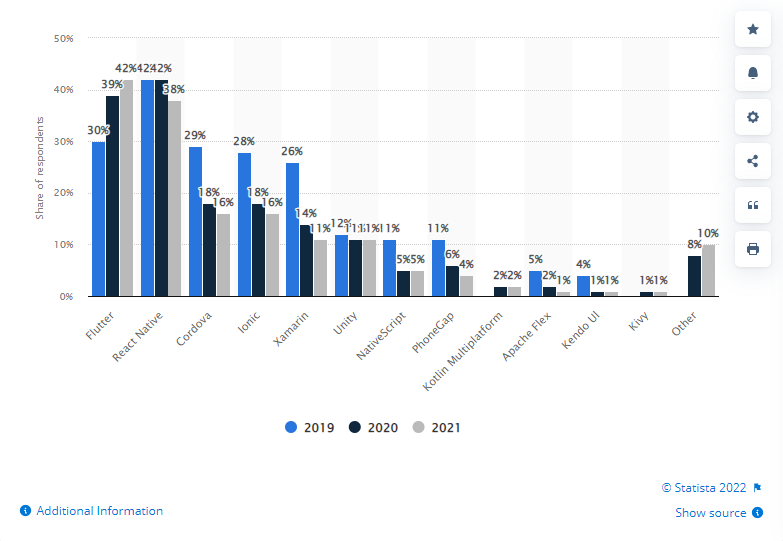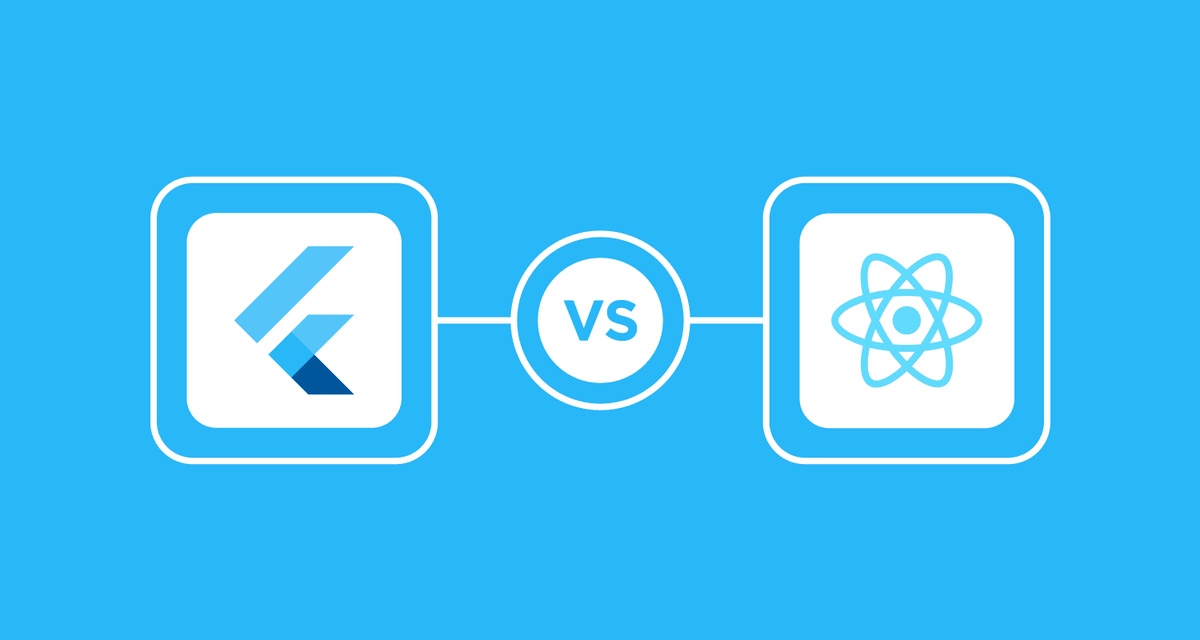Flutter and React Native, both are widely accepted frameworks for cross-platform software development. Their adoption is growing continuously and surpasses the competition.
If we consider Flutter vs React Native, both frameworks aid programmers mitigate the time to market, helping them in offering interactive business apps to customers and enhancing productivity.
According to the 2021 developer survey, Flutter and React Native are the extensively used framework by developers.

Image: https://prnt.sc/UDedty7xV1zO
In this post, we will discover the pros and cons of both frameworks. So, let’s start exploring.
Flutter
Flutter is a cross-platform user interface framework developed and backed by Google. It uses Dart programming language. Dart is also developed by Google and is using Flutter in some of its best apps. Flutter’s key selling point is its ability to support cross-platform frameworks using a single codebase.
Benefits of Flutter Framework
|1. Hot reload
Through hot reload, developers and designers can rapidly determine all the modifications and upgrades that have been performed to the codebase instantly in the app.
Thus, Hot reload bolsters a bond between designers and developers when they want to enhance app looks and feel and checks the effect on the go.
|2. High performance
A ton of factors affect the app performance like CPU usage, request number/second, frame number/second, average response time, etc. The Flutter rate is 60fps, at which contemporary screens showcase a clear picture.
With this rate, a person's eye can discover any delay. If you compare it with frameworks like React Native and Xamarin, Flutter is leading with a 220-millisecond launch time and 58fps.
|3. Immediate Updates
With Flutter’s Hot reload ability, you can get immediate updates without any plugin requirements. A hot reload also lets you see updates in real time. If you detect any issue during code execution, Flutter enables you to fix it instantly and carry on without restarting it.
It enhances productivity and also enables experimentation without long delays, and helps with rapid iterations.
|4. Tailored Widgets for Fast UI coding
Flutter has ready-designed and custom widgets to build superior app UI. However, different methods could be used by various objects like controllers, views, and layout, Flutter features a consistent and unified object model.
Each object is a widget like fonts, menus, colour schemes, padding, buttons, etc. By merging the widgets to make layouts, you can use widgets at any level. The Flutter widgets are consistent and contain wide-ranging abilities.
|5. Moderate Learning Curve
Learning a Dart language is very easy. Programmers with little coding knowledge can build prototypes and apps with Flutter. The experience of mobile app development will not be considered in this development.
|6. Cross-platform Rendering Engine
Flutter contains a powerful rendering engine to render a cross-platform app without any impact on UI changes. It utilises skia for rendering and provides excellent cross-platform integration to aid users to use the app efficiently on any platform.
Disadvantages of Flutter Framework
- The applications developed using the Flutter framework are more likely to be weighty ones.
- The browser does not support Flutter-based applications as of now. It means no web applications.
- Even though the Flutter framework is well-known, it has not been around long enough to have an extensive resource base. So, the team needs to write many things from scratch.
- Dart is not a popular programming language. If you want to write code using the Flutter framework, it is necessary to learn it.
- It lacks third-party libraries.
- Some issues with the iOS platform.
React Native
React Native is another widely-adopted cross-platform framework developed and backed by Facebook. It is based on ReactJS which uses JavaScript to build apps for iOS and Android. Just like Flutter, it is also enabled to build apps through a single code.
Benefits of React Native Framework
|1. Native Look and Feel
React Native merges the building blocks from the native UI with its own JS to give an app a native-like look. Additionally, as the building blocks are the same for iOS and Android, the application appearance is also similar on both platforms.
|2. Live Reload
The live reload lets you view and perform changes in real time. You can fix the code while the app is loading and it will get reflected in the application with an automatic reload. You can also reload specific change zones to save compilation time.
|3. Third-party Plugins
Since app development from scratch can be costly, React Native provides many third-party plugins including JS-based and native modules. The third-party plugins remove the need for particular web view functions and aid improve the app’s features and performance.
|4. UI Focused
React Native leverages the React JS library to develop app interfaces that are quick and responsive. It has excellent rendering capability and uses a component-based method to effortlessly build simple as well as complicated UI designs.
|5. Code Reusability
The biggest benefit of React Native is that programmers do not need to write individual codes for multiple platforms like iOS and Android. Almost 90% of the written code can be reused on both platforms. It boosts development speed and productivity significantly. You will have quick time-to-market and mitigate maintenance efforts.
|6. Cost Effective
As there is a benefit of code reusability, it aids you to save development expenses up to 40%. There is no need to employ two different app development teams for iOS and Android. Additionally, there are multiple pre-built elements in React Native that quicken the development.
|7. Large Community
React native has a large community of more than 50k active contributors. They will help you to get support for any of your queries regarding the framework or development process easily and quickly.
Disadvantages of React Native Framework
- Performance is still lower than native
- Not efficient for complex interfaces
- Lack of some custom modules
- Updating issues
- Difficult to learn
- Quite immature
- Low security
- Complicated UI
- Longer initialisation time
- Memory management
In a Nutshell
React Native is more used due to its usefulness and wide support, but it does not indicate that Flutter falls behind. Flutter is a fresh concept compared to React Native, but quickly it will create a buzz because of its features and abilities.
React Native is more stable today, but Flutter is also growing. It is just a matter of time before both frameworks have their own targeted audiences. Both are suitable to build apps on time while being cost-effective solutions.
No one can anticipate the future of the winner among both. We have to wait and watch how things turn out and which framework offers highly effective solutions to the issues.


No comments yet